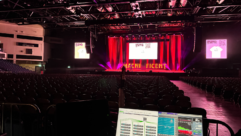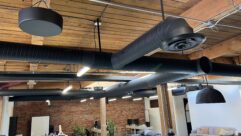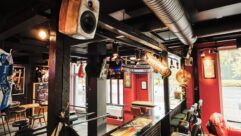Safe and Sound
Apr 1, 2003 12:00 PM,
Dan Daley
The disastrous and lethal fire at the Station in Warwick, Rhode Island, last February shocked the nation. Ninety-nine patrons died after heavy metal rockers Great White set off onstage pyrotechnics that ignited a fire that, within minutes, engulfed the small club. The fire also made many in the installed sound and lighting industries sit up and take notice in a way that previous tragedies haven’t. The Station was not an urban disco operating on the fringe of the codes, like the Happyland Social Club in New York was when an arson blaze there killed 87 in 1990, or Club Puerto Rico in Manhattan, where 25 perished nearly a quarter-century earlier. It wasn’t a Titanic-like anomaly, like the fire that killed 165 people in the upscale Beverly Hills Supper Club in Southgate, Kentucky, in 1977. Rather, the Station was one of thousands of one-room venues throughout the United States, small neighborhood music halls where a mix of ages and incomes gather nightly to hear music and have a few hours of high-decibel relief from reality. It was the bread-and-butter kind of place for local sound system installers and equipment retailers for whom Madison Square Garden happens once in a lifetime or never at all. The Station fire was also notable in that the fuel for the inferno was specifically identified as a product that those in the business use daily: foam intended for sound dampening.
“The day after it happened, we were in a sales meeting, and everyone went to their books and started checking fire ratings on acoustical materials,” says Bob Casey, who works in contractor sales at Dale Pro Audio in New York City and who used to do club sound system installs in the ’70s and ’80s. An author once interviewed Casey for a book on the disco industry. “He asked me if a speaker can catch fire if it gets too much power,” he says. “I said, ‘Definitely.’ I’ve seen it happen when a cheap power amp starts clipping to the point where it puts out a DC square wave. All this makes you remember that there are a lot of things we deal with every day that can cause a major problem if they’re not handled right.”
The egg-crate-pocked polyurethane foam that the Station’s owners allegedly installed in response to noise complaints had two fatal flaws. According to published reports during the initial investigations, the foam was of the nonarchitectural type, not designed for acoustical applications and useless at stopping the major source of noise complaints about clubs, which is bass, and was chosen on the basis of cost, not effectiveness. Secondly, it was not installed by anyone with significant experience in acoustics. At a time when the economy is down and everyone is looking to trim overhead, professionals start to look too pricey to many venues. The trouble is the cost of not using one could be higher than ever imagined.
Ironically, there could be negative implications from the Warwick blaze against the pro installation sector. “It puts what we all do in an unfair light,” says David Malekpour, president of Pro Audio Design in Boston, who is well aware that that city was the site of the nation’s worst-ever club fire, at the Coconut Grove club in November 1942, which left 491 people dead and caused drastic revisions in Boston’s building code regulations. “This is not something that a professional would have done, but there are a lot of people out there who are in this ‘do-it-yourself’ mode of thinking. To them foam is foam, and it’s soundproofing.”
But it’s not, and that puts everyone from the club owner on down at risk of liability. Bruce Jacobson, a Manhattan attorney whose firm handles Mick Taylor and a number of other hard-touring classic rock artists, points out that the chain of liability is lengthy. “The vendor of the material needs to know what the limits of the product are,” he says. “If he knows that the application isn’t appropriate for a particular product, then he could be liable.”
Malekpour and other equipment retailers and system installers often ask buyers what types of applications the equipment they’re purchasing is going to be used for to help them choose the best products for the purpose. Fire rating is one of the criteria he tries to stay aware of. “But you’re competing with ads in the back of magazines for $99 foam products that someone gets through mail order,” he says. “Contractors have to be aware of how the material they install will affect things like safety. But we can’t help anyone if they never come to us in the first place.” Unlike a new construction installation, which would have required an architect and periodic visits from codes inspectors, the implementation of foam in the club was likely viewed as one would a coat of paint. Ironically, it was probably just about as effective as paint in curing the problem it was intended to. “I doubt it had any meaningful effect in terms of soundproofing anyway,” he says. More ironic, and sadder, is the fact that the club had been inspected several times in the three years since the foam had been installed in 2000. Yet according to the Associated Press, in 60 pages of documentation by inspectors during that time, not one mention of the foam was noted, apparently missed by fire and building codes inspectors. In the same AP report, the club’s stage manager and sound engineer, Paul Vanner, said the foam had been there since 2000. Kathleen Hagerty, the attorney who represents the club’s owners, told the AP that her clients had no idea the material was dangerous and didn’t know the foam was made of polyurethane. Aram DerManouelian, president of American Foam Corp., which allegedly sold the foam to the club, had been quoted in earlier reports as saying that the club bought the cheapest material available and that the company only sold foam designed for packaging.
USE OF THE PRODUCT
Art Noxon — president of Acoustical Sciences Corp. in Portland, Oregon, which develops and manufactures sound-conditioning products used in fixed installations — says the nature of the foam material used was one problem. Another was its implementation. “If you have a continuous swath of materials, as seemed to be the case here, the fire will follow that path,” says Noxon, who has advanced degrees in mechanical engineering and physics and is a state-licensed acoustical engineer. “A fundamental design strategy when installing sound-conditioning material is to give flames a place to squander themselves.” He recommends installing acoustical material in a staggered manner, which creates an alternating array of absorption and diffusion for sound and a series of fire breaks in the event of combustion. “Most people who aren’t professionals tend to buy material in 4-by-8-foot sheets. For maximum efficiency, it’s better to use 8-foot-long, 8-inch-wide strips with space between them. It’s more acoustically efficient and certainly safer.”
The amount of foam material, which appeared to cover much of the stage wall area in videos shot during the fire, also likely contributed to the fire’s rapid spread. Noxon estimated that a club with a capacity of 300 people, at about 8 square feet per person and with a 10-foot ceiling, would have about 25,000 cubic feet of volume. Using the Sabine Equation for achieving an RT60 of 1 second or less (recommended for nightclub acoustics), he estimated a club this size requires about 1,250 square feet of sound-absorptive material to create an effect. “The sad irony is that the foam material he put in has no bass absorption characteristics, which was probably the problem they were trying to solve in the first place,” Noxon says. “You need air and traps to stop bass.”
Fire ratings for materials are somewhat arcane; Noxon says the American Society of Testing Materials (ASTM) offers classification based on types of material and ratings of their flammability and smoke-emission characteristics. “You want a product that doesn’t combust explosively and that puts out minimal smoke,” he says.
He suggests that sound system installers considering acoustical materials take samples of them and subject them to a blowtorch, checking for characteristics such as dripping globules of flaming material. In a published report, Don Bliss, the New Hampshire fire marshal and president of the National Association of State Fire Marshals, agreed, saying that assessing materials sometimes requires holding a small sample to an open flame. “It’s an important part of any inspection,” Bliss says.
Noxon suggests another strategy that could have averted disaster. “If you want to reduce a material’s flammability, put it behind a metal screen,” he says. Two or three layers of tightly meshed window screens covering material of the type used in the Station would have acted as a mechanical bumper to the flames while allowing the foam to provide some high-frequency absorption. The mesh could also have deflected the path of the projectile that ignited the flames in the first place.
Could any sound-conditioning material have withstood a direct hit by a pyrotechnic device? “I wonder that myself now,” says Noxon, who says he would add exposing his company’s products to devices such as road flares and sparklers to check their durability.
Installers can take other steps to minimize fire potential in installations, including running wire in conduit between amplifier and speaker. Dan Agne, partner in Sound Investment Audio and a sound system designer for clubs such as Crobar in Miami and New York and Sonoteque in Chicago, says his designs incorporate automation linking audio mixers and fire alarms. “If the alarm system goes off, it triggers a voltage signal that mutes the audio and turns off the [dance] lighting after they’ve properly cooled down,” he says. Casey says Rane’s MP-44 DJ mixer will mute its output by 50 dB automatically when linked to a fire alarm system and leave just one specified mic input available so a DJ or club manager can find and use it quickly to alert patrons how to safely exit a building in an emergency.
Contractors and installers can also go to the Web site for the National Fire Protection Association (www.nfpa.org). It has been updated since the Warwick fire and offers documents for sale, including one on assembly occupancy environments.
There is widespread agreement that the use of a professional systems installer and appropriate acoustical materials could have prevented the Warwick tragedy. However, professionals also concur that they can be more proactive in assessing situations and alerting venues to potential problems. “If you go into a club and see a problem like that, you need to tell someone,” says Casey. “Before this happened, I wouldn’t have thought about that. Now I’d do it in a second.” Adds Malekpour, “This part of our business is now going to be under a microscope, as it should be.”
Dan Daley is a veteran freelance journalist and author, specializing in media and entertainment technology and business sectors. He can be reached at [email protected].
Foam and Flammability
Because most acoustic foam sound treatment materials are made from polymer-based products, flammability is always an issue. Several of the well-known agencies and associations can provide a significant amount of information relevant to testing and rating the flammability of most materials, including the type of foams used for acoustical treatment. Among those are Underwriters Laboratories (UL; www.ul.com), the National Fire Protection Agency (www.nfpa.org), and the ASTM International (www.astm.org). One of the best-known preselection test programs conducted on plastic materials to measure flammability characteristics is described in UL 94, “The Standard for Flammability of Plastic Materials for Parts in Devices and Appliances,” which is now harmonized with IEC 60707, 60695-11-10 and 60695-11-20, and ISO 9772 and 9773. This test determines the material’s tendency either to extinguish or to spread the flame once the specimen has been ignited. There are 12 flame classifications specified in UL 94 that are assigned to materials based on the results of these small-scale flame tests. These classifications are used to distinguish a material’s burning characteristics after test specimens have been exposed to a specified test flame under controlled laboratory conditions. Three of the classifications specifically relate to low-density foam materials commonly used in fabricating speaker grilles and sound-deadening material (HF-1, HF-2, HBF).
Flame Spread Index
Most reputable manufacturers of sound treatment products that offer foam panels have detailed information available about the flammability characteristics of their products. Look for specifications on fire rating, smoke density, and flame spread. The relevant documentation that defines these tests is ASTM E84-01, “Standard Test Method for Surface Burning Characteristics of Building Materials.” The most commonly quoted specification in manufacturers’ literature is the Flame Spread Index. It is defined in E84-01 as “a number or classification indicating a comparative measure derived from observations made during the progress of the boundary of a zone of flame under defined test conditions.” The document clearly details these test conditions and the derivation of the index. It is important to note that the test specifies that materials are tested “with the specimen in the ceiling position with the surface to be evaluated exposed facedown to the ignition source.” Obviously, many polymer or plastic-based materials will melt and drip downward, and the test recognizes that by stating in section 1.4, “Testing of materials that melt, drip, or delaminate to such a degree that the continuity of the flame front is destroyed result in low flame spread indices that do not relate directly to indices obtained by testing materials that remain in place.” When the materials are mounted vertically to a wall surface (the typical application for sound treatment materials), the burning material drips down its own surface, keeping the “flame front” intact, and therefore it could be argued that the flame spread index of wallmounted materials should be adjusted higher. Here are some common reference materials and their flame spread indices, as tested by the ASTM and verified in the E84 document:
Some Common Materials
Polyurethane. Polyurethane (ether) is the egg-crate foam that was used to sound-insulate the Station. It is most often used as packaging material. Common, untreated polyurethane is not fire rated and should not be used as sound treatment material under any circumstances.
Flame-retardant polyurethane. Polyurethane foam can be treated with a fire retardant to increase its resistance to flammability. It will flame, but the fire retardant helps extinguish the flames as it burns. However, it is considered combustible to the point that it presents a fire hazard and would require a sprinkler system.
Melamine. Melamine was developed as a less flammable alternative to polyurethane. It is also more temperature and chemical resistant. It is important to note the flame-retardant properties of melamine. Melamine has been around for almost 170 years but was used only in commercial products beginning on the 1930s. Many acoustic treatment materials are available from several manufacturers in tile made from this chemical compound. It is significantly more flame retardant than polyurethane, with typical flame spread indices as low as 2.5 (compared with 95 for a similar polyurethane-based panel). It will not flame and turns to ash when exposed to flame. Because of its limited combustibility, it doesn’t require fire protection such as sprinklers.
Willtec. Several companies offer a Sonex-type product made from willtec, which is another highly fire-resistant synthetic material that has a flame spread index of 5.
The flammability of panels made from any of the previously mentioned materials will be altered by painting or use of adhesives to mount them to wall or ceiling surfaces.
For More Information
Acoustic Sciences Corp.
www.tubetrap.com
www.asc-soundproof.com
Ž 201
Acoustic System
www.acousticsystems.com
Ž 202
Acoustical Interiors
www.acousticalinteriors.com
Ž 203
Acoustical Solutions
www.acousticalsolutions.com
Ž 204
Acoustical Surfaces
www.acousticalsurfaces.com
Ž 205
Acoustics First Corp.
www.acousticsfirst.com
Ž 206
Auralex Acoustics
www.auralex.com
Ž 207
ClearSonic
www.clearsonic.com
Ž 208
Folded Space Technologies
www.fstechnologies.com
Ž 209
Illbruck
www.illbruck-sonex.com
Ž 210
Markertek
www.markertek.com
Ž 211
MBI Products Company
www.mbiproducts.com
Ž 212
NetWell Noise Control
www.controlnoise.com
Ž 213
Primacoustics/CableTek Electronics
www.cabletek.ca
Ž 214
RPG Diffusor Systems
www.rpginc.com
Ž 215
Silent Source
www.silentsource.com
Ž 216
Sound Construction and Supply
www.iso-box.com
Ž 217
Taytrix
www.taytrix.com
Ž 218
Vibrant Technologies
www.vibrantech.com
Ž 219
VocalBooth.com
www.vocalbooth.com
Ž 220
Wenger Corp.
www.wengercorp.com
Ž 221
WhisperRoom
www.whisperroom.com
Ž 222
Ž Circle this number on Reader Service Card or visit freeproductinfo.net/svc










